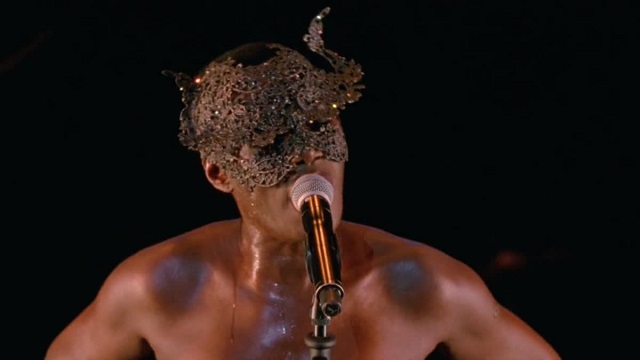Who is Grace Jones and what makes her tick?
Director Sophie Fiennes assumes you know what Grace Jones does: Grace Jones is a legendary Jamaican-American singer/actress/video artist whose career started as a model in the 1960s. In very quick time, she turned herself into an icon through a disco/new wave musical career and a tumultuous relationship with controversial French photographer Jean-Paul Goude. Ms. Jones integrated into the 1980s nightlife scene with Andy Warhol and even scored a top 40 hit with Slave to the Rhythm. She acted in Conan the Barbarian, Vamp, and A View to the Kill, was painted on by Keith Haring, and photographed by Robert Mapplethorpe. If you’re seeing a Grace Jones documentary/concert film, you probably know all this by now…or, at least Fiennes assumes that you would.
Instead of being a career profile, Grace Jones: Bloodlight and Bami is half a concert film and half an deconstruction looking deep into the complex personae of Grace Jones through a kaleidoscope of fly-on-the-wall segments and home videos. Bloodlight and Bami is not for newcomers to the glorious nature of Grace Jones, but for the people already sold on her greatness. Let me put it to you this way: I went to a Sunday afternoon screening and there was an adorable gay cub who went while wearing a Grace Jones concert t-shirt. He’s the target audience for this documentary.
The concert footage was largely underwhelming. Seemingly with only four camera operators, the concert cinematography and editing was very underwhelming and neutral. Using very basic framing techniques and a very small range of perspectives, Sophie Fiennes and cinematographer Remko Schnorr attempt to let Grace Jones be the star of her show and let her outsized dramatics and stage presence do the work of filling the frame. That’s not that Jones gives bad concerts – there’s a laser light show so simple and effective that words do it no justice – but the footage is simply boring. On rare occasions, Jones’ visual art and the theatrical camera find ecstatic harmony; but, this half is largely an uninteresting take on a filmed concert.
On the other hand, the confessional/deconstructive side of Bloodlight and Bami is fascinating, diving deep into the origins of Grace Jones and what continues to make her tick with a blend of behind the scenes footage, seemingly-illicitly captured hotel and cab conversations and home videos of a 2005 visit to Jamaica. Jones is a Performer, a Business Woman, an Abused Jamaican Child, and a Party Girl. One minute, Jones shucks an oyster exclaiming “I wish my pussy was this tight!” The next, she discusses the childhood abuse she suffered at the hands of her grandfather and how she became her abuser as part of the stage show. Back in Paris, Grace storms around a hotel room, complaining that a performance contract is not paying for her hotel room. On the set of a French tv show, the producers surprise her with a pink bubbly set with scantily clad dancers while she comes out in severe black clothing with a hat that covers her eyes; she quickly shuts it down saying that the set up makes her look like a brothel madam but still realizes that the dancers will hate her for firing them.
It’s neither fair nor dishonest to compare Grace Jones: Bloodlight and Bami to Madonna: Truth or Dare. Though both are concert film confessionals, one’s strengths are the other’s faults and vice versa. Madonna’s manufactured conversations are as fake as Grace Jones’ drunken rants are aging diva realness. On the other hand, the concert footage of Truth or Dare is more visually stimulating and complicated than the concert footage in Bloodlight and Bami. Depending on what you want out of the film, you may be ecstatic or disappointed.
That said, I found it absolutely fascinating, especially in the back half. Succeeding in the art world means you have to be open and you have to be tough; you have to be sweet and mean. Jones comments (paraphrased), “they didn’t expect me to have been around this block so many times. More like I’ve been around the globe.” Though we get little insight into Grace Jones the Artist, there is much more insight into Grace Jones as a human entity.

